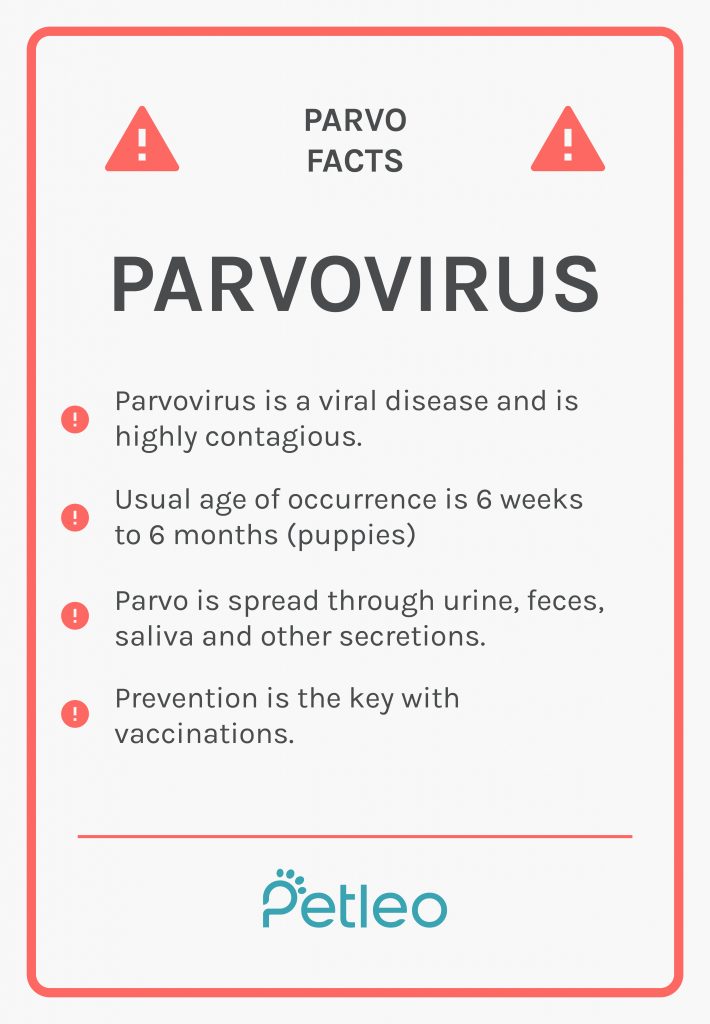Infectious, resistant and deathly. It can persist in the environment for long periods: months or even years. Cases that encountered by veterinarians are often serious, even fatal. It is therefore vital that your dog is protected against this disease.
To better protect your beloved companion, discover the characteristics of PARVOVIRUS.
Definition
Parvoviral Enteritis is a serious and highly contagious disease that is transmitted through the excrement, urine, vomit of infected animals or by contact with contaminated equipment, clothing, shoes, etc. (parvovirus has a very high resistance in the environment).
Puppies are most at risk and the disease spreads very rapidly through the body, weakening the animal within a few days and even causing death.
Parvoviral enteritis was first observed in dogs in 1970’s in Europe and America. Thousands of dogs died from it before a vaccine became available. At present, although such epidemics are no longer observed, parvovirosis remains a common disease in UNVACCINATED dogs.
Symptom
When a dog is infected with parvovirus, it only takes three days to be completely affected. Here are the symptoms that you can observe, on average between 5 to 7 days after contamination:
- Bloody diarrhea
- Fever
- Loss of appetite
- Vomiting
- Rapid weight loss
- Fever
- Signs of dehydration
- Low blood sugar level (hypoglycemia)
This virus severely affects young and unvaccinated dogs.
Rarely, it affects the heart muscles and causes sudden heart failure and sudden death.
Risk factors
This illness may affect all breeds and all ages of dogs. However, most severe cases occurs in puppies 6-24 weeks of age.
Unvaccinated dogs from kennels, shelters are mostly under risk.
Researches also showed that certain breeds have been at risk of severe Canine Parvoviral enteritis. These are:
- American pit bull terrier
- Doberman pinscher
- Rottweiler
- Labrador retriever
- German Shepherd
- Yorkshire terrier
Also some researchers have found a higher fatality rates in some pure breed dogs such as hounds, gundogs than in mixed breed dogs (1).
Diagnosis
As soon as the first symptoms appear, it is urgent to consult the veterinarian quickly.
Your veterinarian will make a first general examination of the animal and will proceed to an analysis of its faeces. It can happen that the result is negative, but that the virus is still present.
Other laboratory tests (hemogram, blood chemistry etc.) can then be taken to confirm the disease.
Treatment
There is no specific treatment for the disease, so prevention remains the key to avoiding this severe disease.
Once the diagnosis has been confirmed, your veterinarian will quickly rehydrate your dog with an intravenous infusion. At the same time, your dog is given anti-vomitants, anti-diarrhea, antibiotics and other medicines. For this reason, your dog could be hospitalized in a quarantine rooms for several days in a veterinary clinic.
Nevertheless, despite all these long, heavy and costly treatments, the animal’s survival remains committed. If it survives, he may have after-effects for the rest of his life (chronic diarrhea etc)
It is recommended that you disinfect your entire interior home with powerful products (bleach) to eliminate all traces of this virus.
Be aware that Parvovirus survives for a minimum of 6 months, or even longer, in an outdoor environment.
Prevention
The only true and recognized effective prevention against parvovirosis is vaccination. It must therefore be carried out as soon as possible (6 – 8 weeks of age).
So, until you can protect your puppy, avoid contact with other potentially infected dogs and only take him out on a leash so that he doesn’t come near other doggies’ droppings.

*Mit dem PetLEO-Impfplan verpassen Sie nicht die Impfung ihres Hundes. Die PetLEO impfplan empfohlenen Impfstoffe basieeren auf den Empfehlungen von StikoVet.*
References:
1- (Houston DM, Ribble CS, Head LL. Risk factors associated with parvovirus enteritis in dogs: 283 cases (1982-1991). J Am Vet Med Assoc. 1996;208(4):542-546.)
canine parvoviral enteritiscanine parvoviruspanleukopeniaparvo


